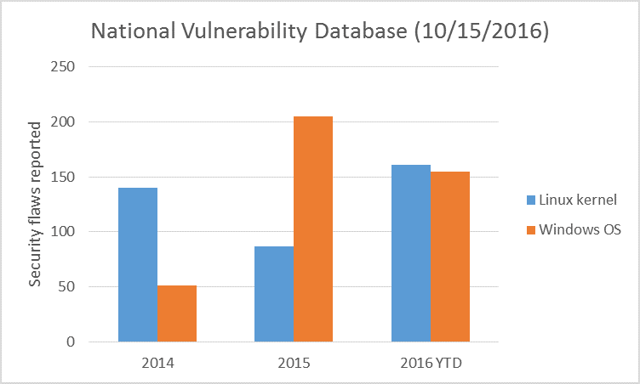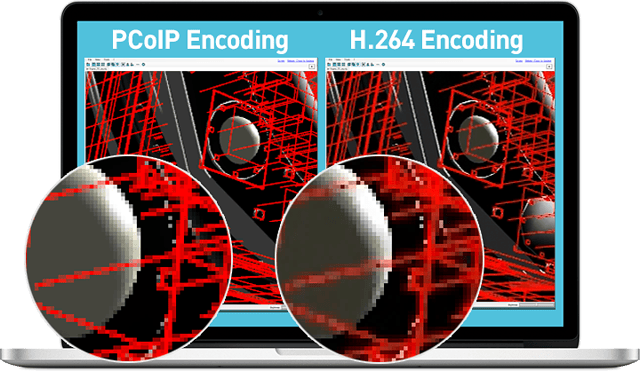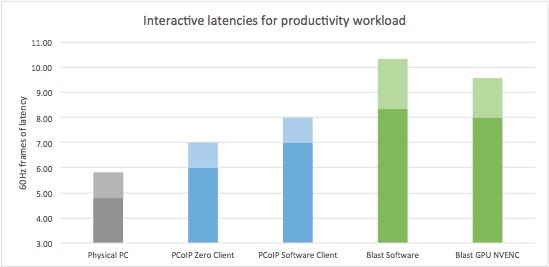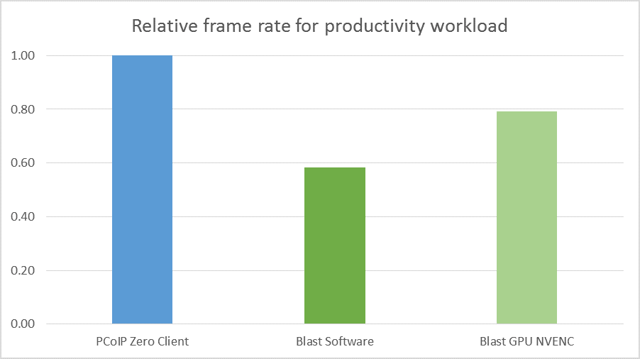HP Teradici
HP Teradici is the inventor of the PCoIP remote display protocol and develops the Engineering Emmy-Award-winning HP Anyware (formerly Teradici CAS) to deliver the best virtual and remote desktop experience in the world.
VMware recently announced the release of the Blast Extreme protocol in VMware Horizon 7, built on the H.264 video codec. A lot of claims have been made that Blast Extreme is now at feature and performance parity with Teradici’s PCoIP or that VMware will eventually drop support of PCoIP. Both claims are far from the truth. Using Blast instead of PCoIP will typically increase the cost of your server and network infrastructure while providing an inferior user experience, higher client management costs, and security exposures. These are some of the reasons customers will continue to demand support for PCoIP.
Fortune 500 VMware customers have completed their own assessments and have chosen to double down on PCoIP and their PCoIP Zero Client investments. Given the estimated 10 Million seats of PCoIP and over 3 Million PCoIP Zero Clients deployed worldwide, VMware will be supporting PCoIP for the foreseeable future. In addition, VMware has publicly committed to maintaining feature parity between PCoIP and Blast when new features are added and we will continue to innovate our PCoIP technology to support the millions of PCoIP users out there.
So, let’s get down to it. Do Blast features and performance measure up to PCoIP? Let’s look at the arguments being made.
Ultra Secure and Easy to Manage Clients: PCoIP Zero Clients Win
Do not be confused by so-called “Blast zero clients” which typically use a Linux-based operating system instead of the stateless and ultra-secure platform on any PCoIP Zero Client. Even a locked-down Linux kernel has >100x larger attack surface than the 5MB of firmware used by PCoIP Zero Clients.
A Blast Linux client is less secure and will require more overhead to manage than a PCoIP Zero Client
As shown in the graph below of reported security vulnerabilities, you can see that Linux is no more secure than Windows and will require constant security patches. A Blast Linux client is less secure and will require more overhead to manage than a PCoIP Zero Client which is why they are deployed by security-conscious Horizon customers in government, healthcare, education, finance and many other vertical markets.

PCoIP Zero Clients provide a better user experience than Blast clients
Now let’s look at the impact on user experience of using Blast clients instead of PCoIP Zero Clients. H.264 uses lossy compression that is not color-accurate. This impacts the image quality of text and graphics as illustrated in the image below. For video and 3D graphics, Blast image quality is one notch below the default PCoIP image quality setting and well below the PCoIP quality settings used for 3D graphics and video editing. Other factors impacting user experience are: interactive latency (the time from a keystroke or mouse click until a change appears on the screen) and frame rate (how rapidly the screen is changing). Let’s take a look at the impact that Blast clients have on these metrics.

PCoIP Zero Clients have lower latency than Blast clients
The following graph shows the interactive latency measured in standard 60Hz frames for this productivity workload on a LAN with essentially no network latency. The interactive latency varies during the workload, so the bars show the median and 90th percentile latencies. The first bar is the latency experienced on a physical PC underneath your desk. Using a PCoIP Zero Client, the latency increases by about 1 frame over the physical PC and the PCoIP software client by about 2 frames. For Blast H.264, the latency increases by more than 3 frames on the same client even with M10 NVENC offload and the variability in latency is higher as well. In all cases, the PCoIP 90th percentile latency is below the median Blast latency.

PCoIP Zero Clients have higher frame rates than Blast clients
The graph below compares the relative frame rates for the productivity workload normalized to the PCoIP frame rate. Without a GPU, the Blast frame rate is 40% lower than PCoIP. The addition of the M10 NVENC offload to Blast does improve the frame rate, but it is still 20% lower than PCoIP.

Battery Life: PCoIP Easier to Configure, More Universal
Blast is claiming “better battery life with less bandwidth,” but these figures are misleading and no supporting data has been made publicly available. Battery life is determined by many things besides protocol decode such as screen lighting, Wi-Fi, LTE, Bluetooth, and GPS power. Furthermore, the applications being used have the biggest impact on protocol battery life. Protocol battery savings are quite logical: static productivity applications drain less power than video ones, which holds true for all protocols.
Comparable or even improved battery life using PCoIP is simple and, better yet, universally available for all devices. PCoIP battery life for video use cases can be increased 40-60% and bandwidth reduced by almost 70% by applying “Profile C” (see Network Optimization Guide for details) to battery-powered devices via VMware “smart policy” settings or through Windows or Linux group policies and configuration files.
Understanding Blast Performance Data
VMware has published a lot of performance data comparing Blast H.264 to PCoIP. All of these comparisons have three things in common:
1. An NVIDIA GPU is always present
2. PCoIP Zero Clients are not included
3. No objective comparison of image quality is made
All three of these factors are very important, read this blog post to find out why Blast requires a NVIDIA GPU .
PCoIP: Delivering the Promise of the Cloud
As you can see, for typical VDI/DaaS users, Blast clients deliver noticiely lower image quality, lower frame rates, and higher interactive latency than PCoIP Zero Clients. Furthermore, we have designed the PCoIP protocol to be hypervisor agnostic, to work on all public, private and hybrid deployments. We have built PCoIP to be multi-codec, to dynamically choose the best codec for the job. And, we will continue to innovate with products such as our new Cloud Access Software, and leverages PCoIP technology to “lift and shift” your own applications, workloads and desktops to the cloud.
Learn more about the differences between PCoIP and Blast Extreme...
HP Teradici
HP Teradici is the inventor of the PCoIP remote display protocol and develops the Engineering Emmy-Award-winning HP Anyware (formerly Teradici CAS) to deliver the best virtual and remote desktop experience in the world.
Posts by Tag
- Cloud Access Software (74)
- PCoIP (69)
- Cloud Computing (43)
- Media & Entertainment (40)
- Cloud Access (38)
- HP Anyware (38)
- PCoIP Technology (35)
- Zero Client (30)
- Teradici CAS (29)
- hybrid work (29)
- AWS (27)
- VDI (23)
- PCoIP Zero Clients (22)
- Amazon Workspaces (21)
- NVIDIA (21)
- CAS (20)
- Microsoft (20)
- PCoIP Ultra (20)
- Azure (19)
- Cloud Access Plus (19)
- Microsoft Azure (19)
- Google Cloud (18)
- GPU (17)
- VMware (17)
- Virtualization (15)
- Cloud Desktops (14)
- Remote Workstation (14)
- VFX (14)
- remote work (14)
- Amazon Web Services (13)
- VMware Horizon (13)
- cloud graphics (13)
- digital workspaces (13)
- Data Security (12)
- Google (12)
- Cloud Workflows (11)
- Amazon (10)
- Cloud Migration (10)
- End-point Security (10)
- GPUs in the Cloud (10)
- Remote Working (10)
- Virtual Desktops (10)
- DaaS (9)
- protocol (9)
- Autodesk (8)
- Cloud (8)
- Dell (8)
- Ian Main (8)
- Pervasive Computing Platform (8)
- SIGGRAPH (8)
- Security (8)
- virtual workstations (8)
- Cloud Workspaces (7)
- Game Development (7)
- Gaming (7)
- Hybrid Cloud (7)
- Interview (7)
- PCoIP Workstation Access Software (7)
- Remote Display Protocols (7)
- Video Editing (7)
- architecture (7)
- macos (7)
- multicloud (7)
- remote visualization (7)
- 3D graphics (6)
- Architecture Engineering Construction (6)
- Blast Extreme (6)
- Blast Extreme Vs PCoIP (6)
- CAD (6)
- COVID-19 (6)
- Cloud Access Platform (6)
- Collaboration (6)
- Desktop Access (6)
- Events (6)
- H.264 (6)
- HP (6)
- Hardware Accelerator (6)
- Horizon Protocols (6)
- NVIDIA Grid (6)
- Wacom (6)
- remote workforce (6)
- AMD (5)
- AWS re:Invent (5)
- Adobe (5)
- All Access (5)
- CAM (5)
- Cloud Security (5)
- Getting to know... (5)
- IGEL (5)
- Inside Teradici (5)
- NABShow (5)
- PCoIP Management Console (5)
- Q & A (5)
- Remote worksation (5)
- Thin Clients (5)
- Webinar (5)
- coronavirus (5)
- quarantine (5)
- remote graphics (5)
- Cloud Endpoints (4)
- Cybersecurity (4)
- GPU-Accelerated Cloud (4)
- Google Cloud Platform (4)
- HPE (4)
- Linux (4)
- Microsoft Ignite (4)
- N-Series GPU (4)
- NVIDIA GPU (4)
- Randy Groves (4)
- Remote Workspace (4)
- User Experience (4)
- auto offload (4)
- lossless (4)
- mac (4)
- AWS Marketplace (3)
- Amazon Workspace Graphics Bundle (3)
- Anyware Manager (3)
- Architecture, Engineering, and Construction (3)
- AutoCAD (3)
- Avid (3)
- CAD in the Cloud (3)
- Codecs (3)
- Dan Cordingley (3)
- Disaster Recovery (3)
- GCP (3)
- GTC (3)
- Google Cloud Next (3)
- Google Next (3)
- IBC (3)
- Jellyfish Pictures (3)
- LG (3)
- LucasFilm (3)
- Management Console (3)
- Maya (3)
- Microsoft Azure Marketplace (3)
- NAB (3)
- NVIDIA NVENC (3)
- Qumulo (3)
- Remote Desktop (3)
- Sohonet (3)
- Video (3)
- Virtual Machines (3)
- Workstations in the Cloud (3)
- Zero Client Deployment (3)
- broadcasting (3)
- business continuity (3)
- cas manager (3)
- linux desktops (3)
- movie production (3)
- pcoip encoding (3)
- remote workstation card (3)
- vmworld (3)
- zero trust architecture (3)
- 3D Workflow (2)
- AWS Graphics Bundles (2)
- AWS re:Invent 2018 (2)
- Adobe Premiere (2)
- Alex Herrera (2)
- Alta PCoIP Zero Clients (2)
- Amulet Hotkey (2)
- Apple (2)
- Arjen van der Meulen (2)
- Cloud Access Manager (2)
- Customer Story (2)
- DNEG (2)
- David Smith (2)
- EC2 Elastic GPU (2)
- FIPS (2)
- Federal Government (2)
- HP ZCentral Remote Boost (2)
- HTML5 (2)
- Healthcare (2)
- IBC 2018 (2)
- IBC 2019 (2)
- IBM (2)
- ILM (2)
- Industrial Light & Magic (2)
- Microsoft Build (2)
- Moore's Law (2)
- NVIDIA M60 (2)
- NVIDIA RTX6000 GPU (2)
- Oil & Gas (2)
- Scanline (2)
- Trusted Zero Client (2)
- VMworld 2016 (2)
- Workstation (2)
- Workstation Access (2)
- Z by HP (2)
- aws re:Invent 2019 (2)
- cloud solutions (2)
- data scientists (2)
- emmy (2)
- finance (2)
- hammerspace (2)
- lenovo (2)
- macstadium (2)
- omniverse (2)
- partner solutions (2)
- private cloud (2)
- server offload (2)
- tehama (2)
- virtual studio (2)
- wacom tablet (2)
- 10ZiG (1)
- 4K (1)
- 4K UHD Display (1)
- AEC (1)
- AI (1)
- AWS Endpoints (1)
- AWS Outposts (1)
- Adobe After Effects (1)
- Adobe Creative Suite (1)
- Adrian Graham (1)
- Android (1)
- Animation World (1)
- AnythingIT (1)
- Anyware Connector (1)
- Appsbroker (1)
- ArcGIS Pro (1)
- Atomic Cartoons (1)
- Autodesk 3DS Max (1)
- BCCDC (1)
- BVE (1)
- Bandwidth (1)
- Battery Life (1)
- BeBop Technology (1)
- Beaufort Memorial Hospital (1)
- Big Data (1)
- Brown Bag Films (1)
- CEEF16 (1)
- CP Technologies (1)
- CPU Load (1)
- CRN (1)
- Cadalyst (1)
- Careers (1)
- Celebrating 3 Million PCoIP Zero Clients (1)
- Certificate Management (1)
- Chris Feeney (1)
- Christus Health (1)
- Chrome (1)
- Chromebook (1)
- Cisco (1)
- Clearcube (1)
- Cloud Expo Europe (1)
- Cloud Expo Europe 2016 (1)
- Cloud Foundry Foundation (1)
- Compute (1)
- Connection Health Monitor (1)
- Crafty Apes (1)
- D-Wave (1)
- DISRUPT (1)
- DISRUPT EUC (1)
- DISRUPT Unite (1)
- DISRUPT2019 (1)
- DSB Consulting (1)
- Data Center 100 (1)
- Dell EMC (1)
- Disaster Recovery Plan (1)
- Disney (1)
- Don Listwin (1)
- EUC (1)
- Education (1)
- Elastic GPU (1)
- Emanuel Pirker (1)
- End User Computing (1)
- Esri (1)
- Event (1)
- Facebook (1)
- Fairfield Energy (1)
- Forbes (1)
- Forrest Smith (1)
- G3 Instances (1)
- GIS (1)
- General Availability (1)
- Google Cloud Marketplace (1)
- Google Marketplace (1)
- Government (1)
- Guest Post (1)
- HP RGS (1)
- HP t310 Quad-Display Zero Client (1)
- HP t310 Zero Client (1)
- HPA (1)
- HPE LoadRunner (1)
- HPE ProLiant (1)
- Hewlett Packard Enterprise (1)
- Higher Education (1)
- Hollywood Professional Association (1)
- Hyperclouds (1)
- IT Business Edge (1)
- Imprivata (1)
- Imprivata OneSign (1)
- Intel (1)
- Intel oneAPI Rendering Toolkit (1)
- Jeff Groudan (1)
- Jensen Huang (1)
- Jeremy Smith (1)
- Jon Peddie Research (1)
- Karan Batta (1)
- LDAP (1)
- MESA (1)
- Martin Traute (1)
- Mason City Clinics (1)
- Meltdown (1)
- Metro Health (1)
- Microsoft AVD Deployment (1)
- Mirela Cunjalo (1)
- NAB2017 (1)
- NAB2018 (1)
- NAB2019 (1)
- Neverware (1)
- Nexenta Systems (1)
- Nuke (1)
- OEM (1)
- OpenSDS (1)
- PCoIP Client (1)
- Quad Display (1)
- Quantum Computing (1)
- Rachel Berry (1)
- Rajen Sheth (1)
- Recycle (1)
- Release (1)
- Remote Display Protocol (1)
- SSO (1)
- Sagar Rawal (1)
- Sam Ramji (1)
- Schlumberger (1)
- Single Sign-On (1)
- Softlayer (1)
- Sony Pictures (1)
- Spectre (1)
- Star Wars (1)
- Steve Mueller (1)
- Stratodesk (1)
- Tablet (1)
- Tarkan Maner (1)
- Tech Talk Thursdays (1)
- TechTalk Thursdays (1)
- Tera2 (1)
- Terraform (1)
- The Angry Birds Movie (1)
- The Channel Co. (1)
- The Register (1)
- Thick Clients (1)
- Unigine Heaven (1)
- University of Waterloo (1)
- VDI Server Benchmarks (1)
- VDI Servers (1)
- VMBlog (1)
- VMware Horizon Clients (1)
- Virtual Reality (1)
- Virtualization 50 (1)
- Visualization (1)
- Webinar Series (1)
- Whitepaper (1)
- Work-from-Home Rapid Response Guide (1)
- Wyse (1)
- YOUNGTECH (1)
- Ziad Lamman (1)
- avid media composer (1)
- blade workstation (1)
- brianmadden.com (1)
- cleverDome (1)
- cloud deployments (1)
- community (1)
- connection broker (1)
- covid19 (1)
- dashboard (1)
- fabulatech (1)
- gpu acceleration (1)
- graphics acceleration (1)
- hypervisor (1)
- latency (1)
- leostream (1)
- local termination (1)
- nutanix (1)
- presentation (1)
- project workflows (1)
- promotion (1)
- protocol comparison (1)
- reference architecture (1)
- schools (1)
- studio Q (1)
- survey (1)
- technology partner program (1)
- test & monitoring tool (1)
- training (1)
- usb peripheral support (1)
- validation video (1)
- virtual display devices (1)
- virtual machine (1)
- vmware solution exchange (1)
- vsphere (1)
- webcam support (1)
- windows (1)
- windows virtual desktop (1)
- work from home (1)
- wvd (1)
- zero trust (1)
